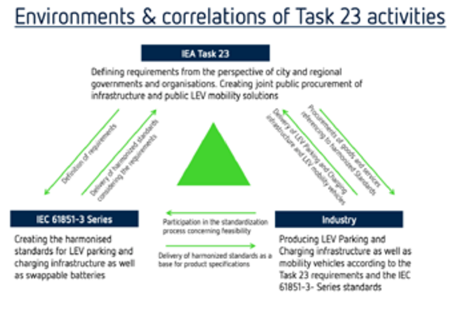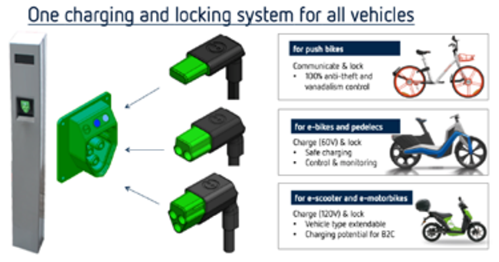Task 23
Light-Electric-Vehicle Parking and Charging Infrastructure
OBJECTIVE OF TASK
Task 23 started during 2013 at Barcelona: Light Electric Vehicles, to address concerns such as bicycle parking (and charging) being cumbersome, as well as the common occurrence of theft of such vehicles—or at least that the threat of has been dominating the daily life of most users. Also, as of the task’s starting point, charging was predominantly done by removing the batteries and charging them in the apartments of the users with proprietary chargers, which in many cases are not built according to state of the art.
Globally, these situations have caused thousands of hazardous fires, with approximately 500+ deaths as of 2013 and likely several thousands by today (2023). Common root causes of battery fires include the overcharging of batteries, on account of accidental misalignment of chargers by users, due to commonly-used non-harmonized connectors, no communication between chargers and batteries/vehicles during the power transfer, and unsafe construction of battery packs. Certain LEV battery packs can potentially catch fire suddenly while charging in apartments or in staircases and set everything on fire in seconds, risking inhabitants’ ability to evacuate safely in case of emergency.
In 2010, the EU government agreed Mandate 468, which asked for a harmonized charging interface for LEVs. The formation of the International Electrotechnical Commission (IEC) was based on this EU Mandate, with a standardization project started in 2012, and Task 23 established in 2013 to coordinate the interests of the governments, local governments and regions within the standardization project.
One of the goals of Task 23 is to trigger the industrial supply chain of products and solutions which do fulfill the IEC TS 61851-3-Series ecosystem boundary conditions. This is intended to be done through understanding the urgent needs of cities in terms of trial tendering processes, and as a result, establishing a blueprint for further public tenders. In cooperation with the City of Hannover, a first trial tender is scheduled to be released in Summer 2023. The standardization process around the IEC TS 61851-3-Series, with its many references, is due for publication by July 2023.
Within the period 2021 and 2022, in collaboration with the EU Project CME iEMS lead by the City of Arnhem, pilot Infrastructure and vehicles have been built and trialed in the City of Stuttgart and Schwäbisch Gmünd, confirming the benefits of this technical solution for the convenience, safety and security of the users of all kinds of LEVs.
The Handbook with the public tender blueprint is set to be published within 2023, which is the final year of Task 23. By September 2024, within the EU, only Pedelecs which are constructed according to the requirements of the IEC TS 61851-3-Series are legal to be sold due to mandatory references in the machinery directive base of the CE requirements for Pedelecs.

Figure 1 The interaction between Task 23, the standardization/ governmental regulation and industry supply. Source: Anke Torkuhl

Figure 2 The three versions of the IEC connectors for public charging of LEVs, all fitting into the same sockets to be installed in public and semi-public locations. The three pin connector version is meant for larger motor scooters or LEVs – this connector can handle up to 7.2 kW charge current at voltages up to 120 V DC. The two pin connector will be probably the most popular with power limited to 3.6 kW charge current and a maximum voltage of 60 V DC. The zero pin connector could be used for non electric cycles which also use bicycle parking facilities. Source: Anke Torkuhl
WORKING METHOD
- Representing the interests of local governments in standardization groups on national, regional and international level
- Participation in national and international events with presentations and exhibitions
- Cooperating with governments and local governments on public tendering’s
- Cooperate on pilot implementations with local governments and industry players.
RESULTS
- Publish final handbook as joint Publication of IEA HEV TCP Task 23 and EU CME iEMS Interreg Project
- Blueprint for public tenders
- Pilot ecosystem implementations
- Published harmonized standard set covering the LEV Ecosystem for safe parking and charging
- Example legal implementation of these standards
OBJECTIVE OF TASK
Task 23 started during 2013 at Barcelona: Light Electric Vehicles, to address concerns such as bicycle parking (and charging) being cumbersome, as well as the common occurrence of theft of such vehicles—or at least that the threat of has been dominating the daily life of most users. Also, as of the task’s starting point, charging was predominantly done by removing the batteries and charging them in the apartments of the users with proprietary chargers, which in many cases are not built according to state of the art.
Globally, these situations have caused thousands of hazardous fires, with approximately 500+ deaths as of 2013 and likely several thousands by today (2023). Common root causes of battery fires include the overcharging of batteries, on account of accidental misalignment of chargers by users, due to commonly-used non-harmonized connectors, no communication between chargers and batteries/vehicles during the power transfer, and unsafe construction of battery packs. Certain LEV battery packs can potentially catch fire suddenly while charging in apartments or in staircases and set everything on fire in seconds, risking inhabitants’ ability to evacuate safely in case of emergency.
In 2010, the EU government agreed Mandate 468, which asked for a harmonized charging interface for LEVs. The formation of the International Electrotechnical Commission (IEC) was based on this EU Mandate, with a standardization project started in 2012, and Task 23 established in 2013 to coordinate the interests of the governments, local governments and regions within the standardization project.
One of the goals of Task 23 is to trigger the industrial supply chain of products and solutions which do fulfill the IEC TS 61851-3-Series ecosystem boundary conditions. This is intended to be done through understanding the urgent needs of cities in terms of trial tendering processes, and as a result, establishing a blueprint for further public tenders. In cooperation with the City of Hannover, a first trial tender is scheduled to be released in Summer 2023. The standardization process around the IEC TS 61851-3-Series, with its many references, is due for publication by July 2023.
Within the period 2021 and 2022, in collaboration with the EU Project CME iEMS lead by the City of Arnhem, pilot Infrastructure and vehicles have been built and trialed in the City of Stuttgart and Schwäbisch Gmünd, confirming the benefits of this technical solution for the convenience, safety and security of the users of all kinds of LEVs.
The Handbook with the public tender blueprint is set to be published within 2023, which is the final year of Task 23. By September 2024, within the EU, only Pedelecs which are constructed according to the requirements of the IEC TS 61851-3-Series are legal to be sold due to mandatory references in the machinery directive base of the CE requirements for Pedelecs.

Figure 1 The interaction between Task 23, the standardization/ governmental regulation and industry supply. Source: Anke Torkuhl

Figure 2 The three versions of the IEC connectors for public charging of LEVs, all fitting into the same sockets to be installed in public and semi-public locations. The three pin connector version is meant for larger motor scooters or LEVs – this connector can handle up to 7.2 kW charge current at voltages up to 120 V DC. The two pin connector will be probably the most popular with power limited to 3.6 kW charge current and a maximum voltage of 60 V DC. The zero pin connector could be used for non electric cycles which also use bicycle parking facilities. Source: Anke Torkuhl
WORKING METHOD
- Representing the interests of local governments in standardization groups on national, regional and international level
- Participation in national and international events with presentations and exhibitions
- Cooperating with governments and local governments on public tendering’s
- Cooperate on pilot implementations with local governments and industry players.
RESULTS
- Publish final handbook as joint Publication of IEA HEV TCP Task 23 and EU CME iEMS Interreg Project
- Blueprint for public tenders
- Pilot ecosystem implementations
- Published harmonized standard set covering the LEV Ecosystem for safe parking and charging
- Example legal implementation of these standards
 Back to Tasks
Back to Tasks